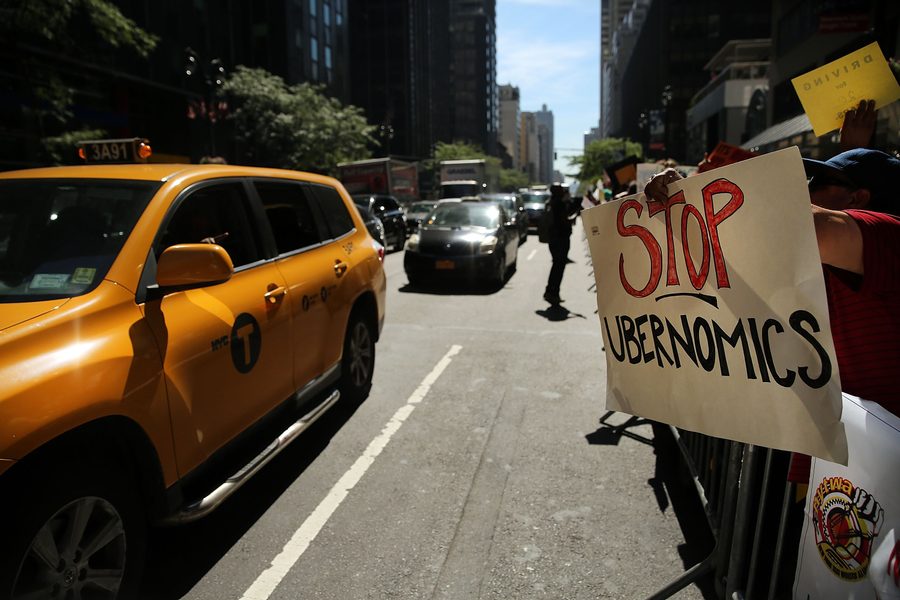New York City Drivers Cooperative Aims to Smash Uber’s Exploitative Model
The city’s first worker-owned ridesharing app gets ready to take on the big boys.
Hamilton Nolan

Ken Lewis grew up on the island of Grenada, and witnessed the progressive aftermath of its 1979 revolution. “I remember the power of cooperatives, people getting land, turning places that were barren into productive places,” he says. That image stayed with him after he moved to New York City for grad school and started driving a taxi on the side. Now, several decades later, Lewis is finally getting a chance to put the power of cooperatives into practice, in service of the drivers he worked with for so long.
He is one of three cofounders of The Drivers Cooperative (TDC), which aims to realize a long-held dream of socially conscious New Yorkers in a hurry: a ridesharing app that you can feel good about. When it rolls out to the public early next year, TDC will become New York City’s first worker-owned ridesharing platform — owned by the drivers themselves, rather than by big investors and executives. Its founders’ brazen idea is that TDC can actually gain a competitive advantage over Uber and Lyft — saving money and funneling those savings back to drivers — by doing away with the most exploitative practices of that dominant duopoly. “The way the [Uber] model is organized is extractive. It takes out the money and doesn’t give back much. Imagine a company that doesn’t have any profits, but has created billionaires,” Lewis says. “That money comes from drivers.”
Erik Forman, a veteran labor activist and organizer, became intimately acquainted with the dark side of that extractive model when he was working as a staff member at the Independent Drivers Guild, a union-affiliated group that organizes rideshare drivers in New York. Companies that operate in the industry regularly push much of the risk of employment onto the drivers by classifying them as “independent contractors” rather than employees. But they also push the costs of the job onto the workers, forcing them to pay for their own car and maintenance (not to mention things like healthcare benefits). Instead of being paid to work, in other words, ridesharing apps — like other “gig economy” companies — make people pay in order to work. When Uber launched in New York City in 2011, it was an attractive alternative for many who had previously been taxi drivers, with decent pay and little regulation. But in subsequent years, Uber cut pay rates while the number of drivers rose, leaving many who had taken out loans to buy cars for their job struggling to meet their debt obligations and earn a living.
Forman, who has been through bitter union battles with big companies, realized that for the same amount of effort, workers could probably start their own venture — leading him to help cofound the ridesharing coop. “The industry seems uniquely in need of a system change based on worker ownership,” he says. “[TDC] is not another company trying to get money out of drivers. It’s the opposite.”
In fact, the lack of exploitation is also The Drivers Cooperative’s financial advantage. For one thing, the billions of dollars that Uber has spent on marketing the concept of ridesharing mean that TDC has little need for big ad budgets. Their plan is to grow by building a network of drivers, using press and word of mouth. And while Uber and Lyft take around a quarter of the money from each trip (some of it to pay for all that marketing), the coop plans to take only 15%. By combining the purchasing power of all the members, they hope to lower expenses on costs like gas and insurance — expenses that Uber and Lyft drivers must handle on their own. They project that this should all add up to 8-10% higher earnings for drivers on every ride, even while being able to beat their competitors on fare prices. And if the coop has any profits left at the end of the year, they will be paid out to drivers as dividends.
Nobody understands the fundamental contrast with Uber’s business model better than the third cofounder, Alissa Orlando — because she used to work for Uber. Her stint as the head of Uber’s operations in East Africa left her disillusioned with the company’s predatory control over its drivers, embodied in the way it unilaterally cut earnings, deactivated drivers altogether, or saddled them with unsustainable car loans, all while claiming they were working together. “We called drivers partners to the extent that it helped us” maintain favorable regulatory status, Orlando says, “but they were never partners.”
Now she is using her experience in venture capital and platform-based businesses on behalf of TDC, a scrappier job that allows her to sleep better at night. Meeting with New York City drivers to recruit them into the coop, she’s heard countless stories of the impossible choices that drivers are forced to make — like the woman who said that a half dozen passengers get into her car without a mask every week, but if she objects, they give her a low rating. “She has to make this choice between ensuring that she’s safe, and the potential threat of deactivation,” Orlando says.
Mohammad Hossen, a rideshare driver who serves on the coop’s advisory board, says that the pandemic has acted as an accelerant for the urgency of the new project. His income from driving has fallen by two-thirds, to just $100 a day, and costs for disinfectant and other safety measures — paid out of his own pocket — have gone up. The shared predicament has allowed him to successfully recruit other drivers, while they wait for hours at the airport to get a fare. “At the end of the day, you have no life, no security, no future,” Hossen says. “We realize that, and we suffer.”
That could change when drivers are also the company’s owners. The Drivers Cooperative is starting a pilot project this month giving rides to workers for the Bronx-based Cooperative Home Care Associates, an example of cross-coop cooperation. Founders hope to eventually recruit several thousand drivers in the city, and say recruitment is going well. They aim to roll out their own app and open for business in the first quarter of 2021. Their eventual goal, they say, is 10% of the $5 billion New York City rideshare market, and expansion into other cities. For now, though, they will be satisfied with making a good idea a reality.
Hamilton Nolan is a labor writer for In These Times. He has spent the past decade writing about labor and politics for Gawker, Splinter, The Guardian, and elsewhere. More of his work is on Substack.








